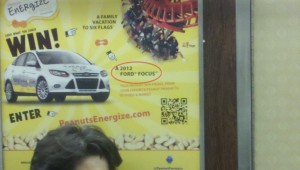How would you like to win a new Ford “Focus”? Probably not a lot because putting the name in quotes is akin to a wink. It’s not really a Focus but a Yugo with a Focus skin of some sort. Or, it’s a cake in the shape of a Ford Focus. Whatever, your response is likely “do not want” and that’s bad news if there is a copywriter who wrote that promo and is getting paid for it.
I mused on this when I saw this ad in the NY Subway last week. And those aren’t really quotes around the word “Focus”. Click on the thumbnail and look at it full size and you’ll see there is actually a register mark after the “Ford” and a TM after “Focus”. WTF?
What is happening here is that some legal beagle is trying to justify their paycheck, unfortunately at the expense of yours. By mindlessly second-guessing the concerns of some other legal beagle in a second company who is also trying to justify their paycheck, they will insist on a trademark or register mark every time a brand is mentioned. They may also insist on the insertion of qualifiers when none are needed, eg changing “you’ll enjoy driving this car” to “you may enjoy driving this car”.
Why is this harmful? First because it’s idiotic. Second because the little rat-turd looking legal marks clutter up the visual appearance and make the copy difficult to read. Third because it removes any artifice that makes it seem that your communication is “real” vs. hucksterism.
I once backed a very senior legal person into a corner at a large publishing company. They told me that if you use a register mark or other qualifier the first time you mention a brand name on an element, and either credit the owner in a footnote or else simply say that “all trademarks are the property of their respective owners” then you’re good. If it’s a multi-component direct mail package you’d need to do this once on the outer envelope, once on the letter, once on the brochure and so on. Then you’re covered. Anything beyond this is legal self-gratification and self-manipulation and you should fight hard against it.
